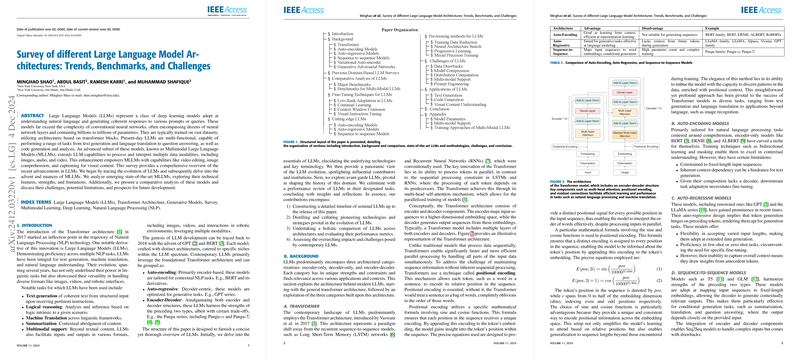Survey of LLM Architectures: An Analytical Synopsis
The paper "Survey of Different LLM Architectures: Trends, Benchmarks, and Challenges" offers an extensive review of the landscape of LLMs. It delineates the evolution, distinctive architectures, benchmarks, and prevailing challenges of LLMs, providing a comprehensive synthesis for experienced researchers in the field of NLP.
Overview and Taxonomy
The survey distinguishes LLMs into three principal architectures: auto-encoding (e.g., BERT, RoBERTa), auto-regressive (e.g., GPT series), and sequence-to-sequence models (e.g., BART, T5). Auto-encoding models are typically employed for understanding tasks due to their masked LLMing techniques, while auto-regressive models excel in generative tasks through their causal attention mechanism. Sequence-to-sequence models combine both capabilities, often utilized for tasks requiring conditional generation like translation.
An evolutionary trajectory is presented, tracing influential models such as GPT's progression from version 1 to 4, and the massive scaling demonstrated by models like PaLM and LLaMA, underlining the growth from millions to trillions of parameters to enhance performance across more complex and diverse tasks.
Benchmarks and Evaluation
The survey emphasizes the significance of standardized benchmarks in assessing LLM performance. Notable benchmarks include MMLU for comprehensive task understanding, SuperGLUE for advanced natural language understanding challenges, and multimodal benchmarks like NLVR2 and VQA, testing the integration of visual and textual data. The competitive landscape outlined in the Open-LLM Leaderboard illustrates the leading models on these benchmarks, highlighting innovations in accuracy and efficiency.
Current Challenges
Key challenges articulated in the survey include massive computational and data requirements, resulting from the expansive parameter sizes and the necessity for extensive training datasets. Model compression techniques like pruning, quantization, and knowledge distillation are discussed as critical means to mitigate these issues, striving for more efficient deployment while maintaining performance.
Multimodal LLMs, extending capabilities to handle diverse data formats, present unique challenges in integrating different modalities (text, image, audio) within unified frameworks, prompting innovation in cross-modal learning strategies.
Pre-training and Fine-tuning Innovations
The paper explores strategies for effective pre-training and fine-tuning of LLMs. It discusses techniques like Low-Rank Adaptation (LoRA) and Parameter-Efficient Fine-Tuning (PEFT), crucial for optimizing models without exorbitant computational demands, making them adaptable across varied applications without extensive retraining.
Implications and Future Prospects
The research indicates the burgeoning potential of LLMs to drive advancements in both practical applications and theoretical understanding. The ability to model complex patterns and generate coherent text continues to benefit industries ranging from healthcare to finance and tech development. However, it also underscores the need for sustainable and responsible AI practices, particularly concerning data quality and model biases.
The paper speculates on future developments, anticipating continued growth in model sizes and capabilities, further integration of AI in multimodal domains, and the proliferation of LLM applications beyond traditional NLP boundaries. These advancements are expected to foster more intuitive and interactive AI systems, bridging gaps across languages, mediums, and tasks.
In summation, this survey not only catalogues the cutting-edge technologies shaping LLMs but also invites ongoing discourse on optimizing these models for broader, safer, and more equitable use. The insights provided are pivotal for researchers seeking to explore the architectural nuances and potential trajectories of LLM development.
